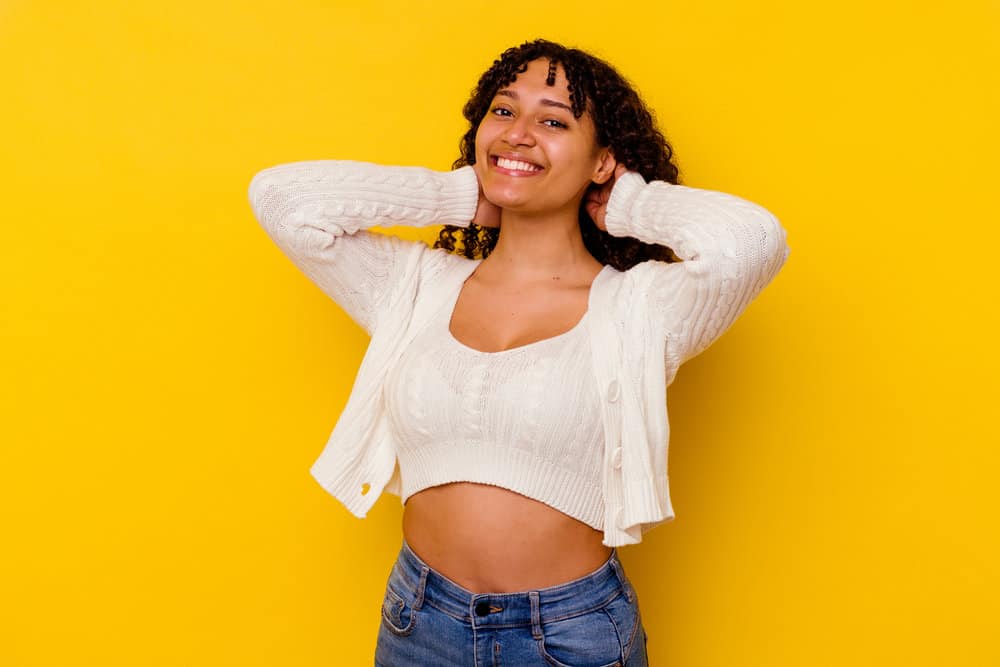
Hair texturizers are a popular way to loosen your curl pattern and create a more uniform curl. But, as time wears on, you’ll notice that your new hair growth doesn’t match your texturized curls.
This scenario makes many people wonder how long they should wait before texturizing their hair again.
Can I retexturize my hair now, or do I need to wait? How long should I wait before texturizing my hair again?
This article will help you decide how long to wait before texturizing your hair a second time. We’ll also walk you through how to maintain your texturized locks, so make sure you read all the way to the end!
Table of Contents
How Long Should I Wait Before Texturizing My Hair Again?
Once you get your first texturizer, you’ll have to get regular touch-ups. This is because texturizers only affect the hair they’re applied to. So, when your new growth starts to grow, it’ll be visibly different from your textured hair.
In addition to looking mix-matched, the sudden transition from your natural texture to your textured hair creates a weak point called a line of demarcation.
Putting even the slightest bit of tension on your stands can cause them to break at the line of demarcation. So, depending on how quickly your hair grows, you should wait between eight to twelve weeks before texturizing your hair again.
After eight to twelve weeks, your new growth will reach about 1.5 inches. This is long enough to reduce your chances of layering the texturizer on your already-treated hair.

What Happens When You Texturize Your Hair Twice?
Though touch-ups are critical to maintaining your texturizer, they come with risks. One of the main reasons experts recommend waiting so long is because of what happens when you apply a texturizer to already texturized hair.
Stacking one texturizer onto another will loosen your curl pattern so much that you lose it completely. The chemical treatment will also leave your hair significantly weaker and may lead to your strands melting off.
The more new growth you have, the more room you’ll have to apply the texturizer. That makes it easier to keep your follow-up treatments on just your virgin hair.

How Long Do Texturizers Last?
Texturizing is a permanent process – make no mistake. So even though your hair still has curls and looks natural, you’ll have to treat your strands like they’ve been chemically altered.
Additionally, you’ll have to be careful about layering additional chemical services over texturized hair. If you want to transition back to natural hair, you’ll have to either cut off the treated strands or wait for new hair to grow and take its place.
Note: Texturizers are chemical treatments, like hair relaxers, and permanently alter your hair's texture. Simply put, texturizers damage your hair much like a hair relaxer. We'll discuss the chemical process and loosening curls in the next section.

Can Texturizing Your Hair Damage It?
Texturizers don’t loosen your curl pattern as much as relaxers, but they still contain harsh chemicals. These chemicals break down the bonds in your hair and rebuild them in a weaker state.
Any time the bonds in your hair are forcibly broken, your hair becomes damaged.
This damage is often compounded by the fact that texturizers are almost exclusively performed on curly, kinky, and coily hair. These hair types are significantly more fragile than straighter hair types, so they are more easily damaged.

Are Texturizers Better Than Relaxers?
While texturizers and relaxers are thought of as two different things, they both use the same active ingredient. The main difference is that texturizers aren’t left to process for as long as relaxers.
However, despite both treatments containing similar ingredients, relaxers are far more damaging. While texturizers leave you with plenty of curls, relaxers are so strong that they completely eliminate your curl pattern.
Keep in mind that this doesn’t mean that texturizers are harmless. It simply means they aren’t as damaging as relaxers when used correctly.
If you leave your texturizer on too long or forget to neutralize it, it’ll continue straightening your hair. That will essentially mimic the effects of a relaxer, both in appearance and in the potential damage risk.

How Do You Maintain Texturized Hair?
Texturizers leave you with beautiful, easy-to-manage curls, but they can also weaken your hair. So, in this section, we’ll look at some of the ways you can keep your hair healthy between texturizing appointments.
Avoid Overwashing Your Hair
Washing your hair is essential to keeping it healthy – everyone knows that. But there can be too much of a good thing when it comes to washing. Shampoo can be extremely drying and strips the moisture out of your already fragile strands.
So, to avoid unnecessary damage, only wash your hair as much as needed.
For most people with texturized hair, this means once or twice a week. You should also use a gentle, sulfate-free shampoo and focus on massaging it into your scalp rather than the ends and mid-lengths of your hair.

Protect Your Hair at Night
If you aren't already protecting your hair at night, now is the time to start! Cotton pillowcases are standard for most, as they are cool and soft to the touch. Unfortunately, they can wreak havoc on your strands as you sleep.
Cotton is highly porous and absorbent and can suck the moisture from your hair.
That leaves your strands dry, brittle, and breakage-prone. So instead, switch to a silk or satin pillowcase, silk scarf, or bonnet. That way, you can ensure the moisture stays where it needs to be - in your hair.

Use Hot Tools Sparingly
Hot tools, like curling wands and flat irons, can make styling your hair fun and exciting. They give you unparalleled freedom and can help you achieve styles you’ve only dreamed of. Unfortunately, they’re also terrible for your hair.
Texturized hair is incredibly fragile, and hot tools can leave them with severe damage.
If you can't avoid hot tool styling altogether, do your best to minimize damage. Coat your strands in a heat protectant, and keep the tools on the coolest heat setting possible.
Avoid putting too much heat on any one section of your hair, and keep the hot tool in constant motion. These steps won’t eliminate the risk of heat damage completely, but they’ll go a long way in keeping your strands safe.

Deep Condition Your Hair Weekly
Regular conditioners are effective, but deep conditioners are even more effective at hydrating your strands. Deep conditioners contain a higher concentration of fortifying and moisturizing ingredients and can improve your hair’s elasticity.
They both repair existing damage and make your strands strong enough to avoid it in the future. For an extra hydration boost, throw on a shower cap after you apply the deep conditioner to your hair.
That will trap your body heat and help the conditioner penetrate your hair more deeply. Alternatively, you can sit under a hooded dryer to generate more treatment-boosting heat.

Use Strengthening Treatments
Your newly texturized curls are significantly weaker than your natural hair. Keep them strong by using plenty of fortifying products, like protein treatments and bond repairers.
Focus your efforts on your ends since they’re the oldest and most fragile parts of your hair. And your ends are the only part of your hair that needs extra attention.
You should also pamper your line of demarcation, where your hair is considered to be at its weakest.
So, there you have it! There’s no set length of time you need to wait before texturizing your hair, but experts agree that you should wait for at least eight to twelve weeks.
That’ll give your new growth plenty of time to grow and help ensure you don't end up with thin or straightened patches.
In addition to keeping your hair gorgeous, waiting the recommended length of time is instrumental in keeping your locks healthy. And we hope that this article has helped show you just that!




